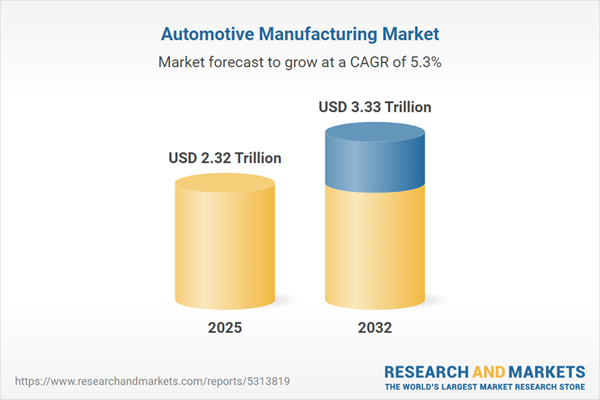Speak directly to the analyst to clarify any post sales queries you may have.
The automotive manufacturing market is navigating a period of profound change, defined by rapid technological progress, evolving consumer expectations, and shifting regulatory environments. Senior leaders face complex challenges as innovation, electrification, and supply chain strategy reshape the competitive landscape.
Market Snapshot: Automotive Manufacturing Market Size and Growth
The Automotive Manufacturing Market grew from USD 2.21 trillion in 2024 to USD 2.32 trillion in 2025. It is expected to continue growing at a CAGR of 5.25%, reaching USD 3.33 trillion by 2032. The market is driven by ongoing investments in electrification, digitalization, and advanced manufacturing technologies, alongside evolving policy frameworks and shifting global supply chains. Regional demand for electric vehicles and increased focus on sustainability further fuel new manufacturing approaches worldwide.
Scope & Segmentation
- Engine Types: Conventional engines, plus a range of electric configurations including battery electric, fuel cell electric, hybrid electric, and plug-in hybrid electric systems.
- Components: Body and exterior parts (such as bumpers, doors, panels, and structural components), interior electronics and components (including advanced driver assistance systems, connectivity, telematics, and infotainment), powertrain components (engines, transmissions), and safety and comfort systems.
- Vehicle Categories: Heavy commercial vehicles, light commercial vehicles, and passenger cars.
- Material Types: Aluminum, composite materials, plastics, and steel, each influencing cost, performance, and sustainability strategies.
- Sales Channels: Aftermarket and original equipment manufacturer sales frameworks.
- Regions Covered: Americas (United States, Canada, Mexico, Brazil, Argentina, Chile, Colombia, Peru); Europe, Middle East & Africa (including United Kingdom, Germany, France, Russia, Italy, Spain, Netherlands, Sweden, Poland, Switzerland, UAE, Saudi Arabia, Qatar, Turkey, Israel, South Africa, Nigeria, Egypt, Kenya); and Asia-Pacific (China, India, Japan, Australia, South Korea, Indonesia, Thailand, Malaysia, Singapore, Taiwan).
- Companies Profiled: AB Volvo, Ford Motor Company, Honda Motor Company, Hyundai Motor Company, Mercedes-Benz AG, Nissan Motor Co., Suzuki Motor Corporation, Tesla, Toyota Motor Corporation, and Volkswagen AG.
Key Takeaways for Senior Decision-Makers
- Emerging technologies such as electrification and digitalization are transforming vehicle architectures, operations, and supply chain models, requiring forward-looking investment strategies.
- Regulatory shifts and environmental policies are prompting automakers to intensify their focus on sustainable materials, recycling, and circular economy practices to stay ahead of compliance requirements and societal expectations.
- Several leading manufacturers are enhancing competitive positioning through vertical integration, strategic alliances with technology partners, and expanding capabilities in next-generation powertrains and software-driven vehicle systems.
- Regional variability in market growth, technology adoption, and government incentives necessitates tailored approaches and localized strategies, particularly for electric vehicles and component sourcing.
- Aftermarket and OEM sales channels present unique opportunities for capturing long-term aftermarket value, driving new approaches to customer retention and service innovation.
Tariff Impact: Navigating 2025 U.S. Trade Developments
The implementation of United States tariffs on key automotive imports in 2025 is a significant turning point for the industry. These tariffs are leading manufacturers and suppliers to reconsider sourcing strategies, prioritize regionalization, and adopt alternative materials or production techniques. Larger companies may benefit from integrated supply chains and risk-sharing joint ventures, while smaller suppliers grapple with increased costs and operational headwinds. The tariff environment is accelerating trends toward near-shoring and encouraging innovation across the North American market.
Methodology & Data Sources
This report synthesizes insights from in-depth interviews with over one hundred senior executives, engineers, and supply chain leaders across global OEMs and Tier One suppliers. The research integrates extensive secondary sources, industry reports, technical papers, regulatory data, and financial disclosures. Data validation is achieved via a structured cross-verification and peer review process to ensure clarity and robustness for decision-makers.
Why This Report Matters
- Enables executives to make informed investment and partnership decisions based on a holistic analysis of key trends, regional dynamics, and competitor actions.
- Supports proactive supply chain strategies and risk management by highlighting critical regulatory, technological, and policy shifts shaping market evolution.
- Delivers actionable insights to accelerate electrification roadmaps, strengthen operational resilience, and drive long-term sustainability initiatives across value chains.
Conclusion
Automotive manufacturing is redefining itself through technology, policy, and evolving supply chain strategies. Leadership teams equipped with current insights can better navigate complexity and secure advantageous positions in a rapidly transforming landscape.
Additional Product Information:
- Purchase of this report includes 1 year online access with quarterly updates.
- This report can be updated on request. Please contact our Customer Experience team using the Ask a Question widget on our website.
Table of Contents
3. Executive Summary
4. Market Overview
7. Cumulative Impact of Artificial Intelligence 2025
Companies Mentioned
The companies profiled in this Automotive Manufacturing market report include:- AB Volvo
- Ford Motor Company
- Honda Motor Company, Ltd.
- Hyundai Motor Company
- Mercedes-Benz AG
- Nissan Motor Co., Ltd.
- Suzuki Motor Corporation
- Tesla, Inc.
- Toyota Motor Corporation
- Volkswagen AG
Table Information
| Report Attribute | Details |
|---|---|
| No. of Pages | 195 |
| Published | November 2025 |
| Forecast Period | 2025 - 2032 |
| Estimated Market Value ( USD | $ 2.32 Trillion |
| Forecasted Market Value ( USD | $ 3.33 Trillion |
| Compound Annual Growth Rate | 5.2% |
| Regions Covered | Global |
| No. of Companies Mentioned | 11 |









